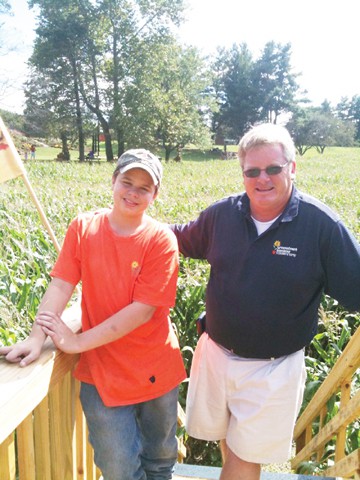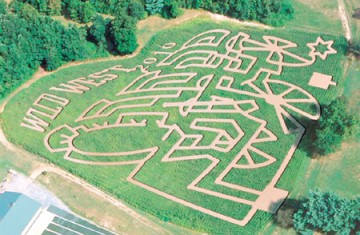Amazing Maize Mazes
Well-trod paths lead to dusty dead-ends. Back to the last turn. Go right instead of left, left instead of right. Until, finally, light at the end of the corn row. High fives all around. A corn maze has been successfully navigated.
A sure sign of fall, these tricky trails through acres of dried cornstalks are a growing business as agri-tourism blossoms.
It’s next to impossible to see on foot, but the maze-trekker has just walked the outline of a giant pirate ship. Or a soldier. Or a Conestoga wagon. These works of field art are experienced at ground level, but their forms can be seen only from above. Like the ancient drawings carved into a Peruvian mountaintop.
Who — or what — are the artists with the talent and vision to create what they cannot see?
Corn maze designers are not space aliens, and their tools are not lasers fired from flying saucers. Imagination — and modern technology — conspire to cut their intricate designs into a field of corn.
The Making of a Maze
Hugh McPherson’s business is farming — and making corn mazes. He put his first corn maze on his Pennsylvania farm in 1998, hoping it would draw people to buy seasonal produce. It was so successful that the next year he started Maize Quest Corn Mazes, a corn maze design and marketing company.
McPherson’s first mazes were designed and cut by hand.
“We did it just like the ancient Egyptians,” McPherson says. “Hand measured, inch by inch, from a drawing.”
Ask any farmer. The work is tedious, at best. Corn towers over humans, and its leaves are razor sharp. Corn fields are full of pollen, bugs, jungle heat and the danger of getting lost.
The contemporary art of maze design is aided by high-tech computers and highly accurate global positioning systems.
At the original Maize Quest farm, the process starts with an annual theme. This year it’s the Salute to the American Soldier.
|
This year’s military-themed maze at Montpelier Farm. |
McPherson and his team gather “iconic images” of the theme. Once they determine the final design, the project is handed over to Designer Dave, who’s been designing mazes for more than 10 years.
“It’s one thing to make a drawing, another thing to make a maze,” McPherson says. “They can’t be so challenging that people want to leave but can’t.”
Using computer-aided design software, Dave creates a three-dimensional representation of the maze, scaled to the size of the field. The scaled image is loaded into a GPS system. But it’s not the same GPS that you’ll find in your car.
“The system we use is incredibly accurate, to within six inches,” McPherson says.
Now Designer Dave passes the job to Cutter Jim, who takes the maze into the field.
“Jim gets on his tractor with the GPS system and cuts out the pathways in a full field of corn,” McPherson says.
The cutting can take anywhere from four hours to two days.
“Every single nook and cranny, every path, need to be cut,” McPherson says. “This year’s design is a soldier holding a gun, with fighter jets flying over his head. That is a lot of detail.”
Not once do any of the maze makers fly overhead to see the design.
From Minotaur to Lothian
Mazes date back more than 4,000 years, with origins in Greek mythology. The Greek hero Theseus literally threaded his way through the maze — designed by the great craftsman Daedalus — to find his way back should he survive battle with the roaring Minotaur. In ancient Rome, mazes were etched in artwork, floors and street pavings, not as puzzles but for rituals and processions.
 |
In the 17th century, “puzzle hedges” were worked into the formal gardens of Europe to amuse kings and their courts. The game was to find the way to the center of the maze and then the way back out.
The first modern corn maze was cut in 1993 at Lebanon Valley College in Pennsylvania by Don Frantz and Adrian Fisher. At the time, their dinosaur maze was the world’s largest, covering 3.3 acres with 1.92 miles of pathways. Corn mazes have now grown to over 10 acres and can span up to five miles of paths.
In Lothian, Ray Greenstreet works with another company, The Maize Group, to design and cut Greenstreet Gardens’ autumnal six-acre corn maze.
“We submit our ideas and go back and forth before we settle on a design,” Greenstreet says. “This year our theme is the Wild, Wild West, and the maze is a Conestoga wagon.”
The Maize Group uses computers and GPS coordinates to cut the design into the corn, but Greenstreet must first grow the perfect canvas.
“We planted special corn that is especially well-suited for a maze,” Greenstreet says. “It grows taller and stronger. It forms ears but no kernels so all the energy goes into the stalk.”
In this dry year, growing corn took more water. Drip irrigation, with an emitter every eight to 12 inches, went on at night, so no water was lost to evaporation.
When the maze season ends, the corn stalks are turned under and composted to return their nutrients to the field for next year’s maze.
Back to the Farm
Why all the time and effort for a design that nobody ever fully sees?
“It’s all about getting people back to the farm,” McPherson says. “People may never think to go to a farm to pick apples, pick pumpkins. The maze introduces them to the farm, the farmer and the farm products. They purchase local food from local farmers, making that farm sustainable.”
Among McPherson’s farm clients is Montpelier Farm in Upper Marlboro.
“This is our third year with a maze,” says farm operator Mike Dunn. “We’re trying to change our farming operation to keep up with the changing population around us. The maze gets people to the farm and gives us the opportunity to teach them about agriculture. It’s education, but it’s also a lot of fun. It’s not just a walk through the corn.”
And it will be that soldier, as Maize Quest sells its year’s design to every customer.
At Greenstreet Gardens, the opening of the maze signals the start of the garden center’s fall season.
“It’s a great way to bring people in for pansies, mums and seasonal décor,” Greenstreet says. “And it’s good family fun.”
It’s real-life fun that breaks the kids from their virtual world and gets them out into nature.
Greenstreet Gardens Corn Maze: Thru October 31, 11am-5pm Sa,Su. Call for nighttime hours. 391 West Bay Front Rd., Lothian. $9.50 w/age discounts: 410-867-9500; www.greenstreetgardens.com
Montpelier Farms Corn Maze: Thru November 7, 5-11pm F; 10am-11pm Sa; 11am-7pm Su; 1720 Crain Highway North (Rt. 301), Upper Marlboro. $10 w/age discounts: 410-320-0464; www.pgcornmaze.com.

